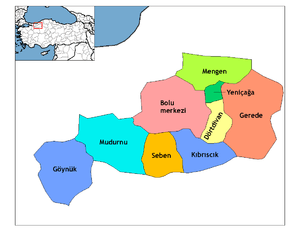Göynük
- For the village in Azerbaijan, see Göynük, Azerbaijan.
| Göynük | |
|---|---|
 Göynük | |
| Coordinates: 40°23′59″N 30°47′07″E / 40.39972°N 30.78528°ECoordinates: 40°23′59″N 30°47′07″E / 40.39972°N 30.78528°E | |
| Country |
|
| Province | Bolu |
| Area[1] | |
| • District | 1,505.06 km2 (581.11 sq mi) |
| Population (2012)[2] | |
| • Urban | 3,895 |
| • District | 15,772 |
| • District density | 10/km2 (27/sq mi) |
| Climate | Csb |
Göynük is a town and a district of Bolu Province in the Black Sea region of Turkey. It covers an area of 1,436 km², and the population (2000) is 18,589 of which 4,894 live in the town of Göynük. The mayor is Kemal Kazan (AKP). Its neighbours are Mudurnu from north-east, Nallıhan from south-east, Sarıcakaya from south, Yenipazar from south-west, Taraklı from west and Akyazı from north-west.
History
The area has a long history of occupation going back to the Phrygians, Lydians, Persians and Ancient Romans. The Çatak Hamamı bathhouse dates back to the Roman times Göynük was absorbed into the Ottoman Empire in the early 14th century. In the late 19th and early 20th century, Göynük was part of the Kastamonu Vilayet of the Ottoman Empire.
Sights

Göynük has over 100 early 20th century Ottoman Empire period houses, these plus the even older mosques, tombs, fountains, and Turkish baths makes it a town of great historical interest, and an attractive location of narrow streets, with a pretty stream running through the centre. The victory tower on the hill at the top of the town and the old Ottoman mansion called "Müderrisoğlu Konağı" at the centre are important landmarks of Göynük.
The most significant entombed saint of Göynük is Akshamsaddin (Turkish: Ak Şemsettin) (1389-1459), an influential Ottoman religious scholar, poet, mystic saint, and guide of Mehmed the Conqueror.[3][4]
Trivia
Göynük was used as a location of films including Akrebin Yolculuğu by Ömer Kavur, El Yazısı and a number of Turkish TV series e.g. Aynalar and Rüzgarlı Bahçe.
Notable natives
- Göynüklü Ahmed Efendi, 18th-century Ottoman bureaucrat, diarist and historian.
- Bıçakçı Ömer Dede, original name Omar Sikkin, an edge tool maker and student of Haji Bayram Wali.[5][6]
- Debbağ Dede, a tanner known for his miracle during the Hajj pilgrimage.[7][8]
- Aksungur Dede, one of the first ghazis to cross from Anatolia to Rumelia, 14th-15th century.[9]
References
- ↑ "Area of regions (including lakes), km²". Regional Statistics Database. Turkish Statistical Institute. 2002. Retrieved 2013-03-05.
- ↑ "Population of province/district centers and towns/villages by districts - 2012". Address Based Population Registration System (ABPRS) Database. Turkish Statistical Institute. Retrieved 2013-02-27.
- ↑ A Part of the Eyoub (i.e., Uyüp) Cemetery, I, Constantinople, Turkey
- ↑ Sûfîlere Yöneltilen Tenkitlere Bir Cevap: Akşemseddin ve Def‘U Metâini’s-Sûfiyye İsimli Eseri
- ↑ BIÇAKÇI ÖMER DEDE (ÖMER SİKKİN) TÜRBESİ
- ↑ Bıçakcı Ömer Dede (k.s.)
- ↑ DEBBAĞ DEDE TÜRBESİ
- ↑ Debbağ Dede
- ↑ Aksungur Dede
